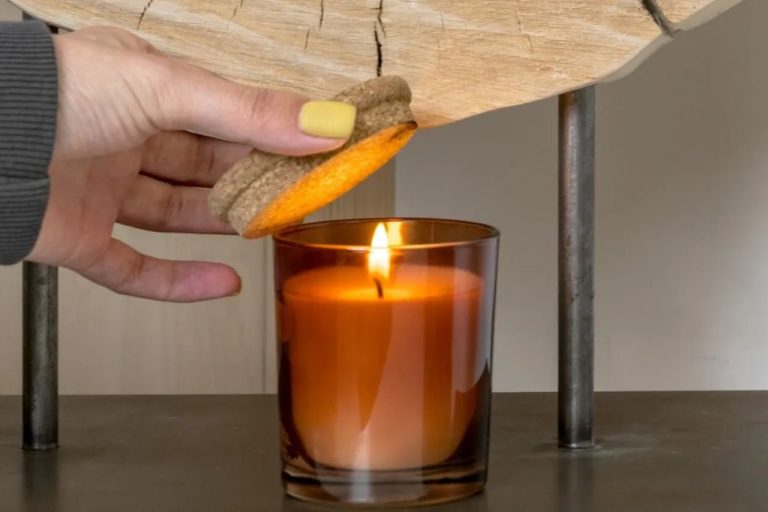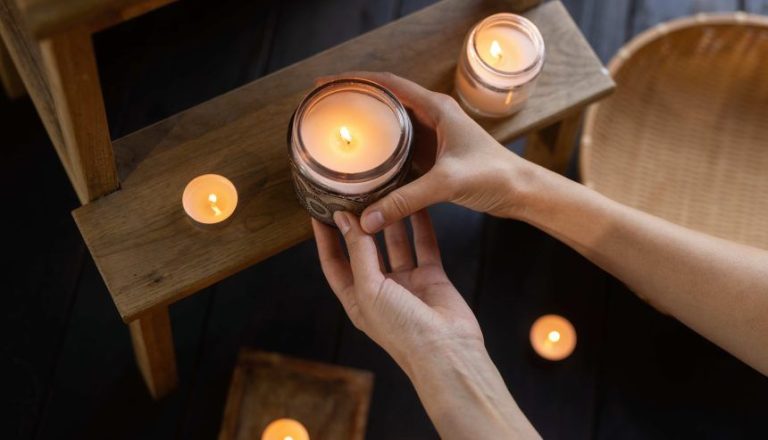Does Burning A Candle Get Rid Of Cooking Smells?
We’ve all been there – you spend hours slaving away in the kitchen to create a delicious meal, only to have the lingering smells of garlic, fish, or burnt food assault your nose for hours afterwards. No matter how much you clean or open the windows, you just can’t seem to get rid of those stubborn cooking odors.
Many people don’t realize that burning a candle can actually help eliminate these unwanted kitchen smells quicker. Candles contain fragrant oils that, when heated, release tiny airborne particles that effectively mask unpleasant odors. The candle doesn’t actually remove the odor molecules, but rather overpowers them with more pleasant scents.
In this article, we’ll explore the science behind how candles eliminate odors, test candle effectiveness on common cooking smells, review the best and worst candle scents to use, provide tips for proper candle burning, and compare candles to other odor removal methods. You’ll learn helpful strategies for using candles to clear the air after cooking up pungent or burnt foods in your kitchen.
How Candles Work to Mask Odors
Candles are able to mask odors through a scientific process called fragrance diffusion. As the candle wax melts from the heat of the flame, fragrant oils are released into the air. These fragrant oils contain molecules that interact with receptors in our noses, overwhelming them with the candle’s intended scent and reducing our ability to detect other odors that may be present.
Not all candle waxes and wicks are created equal when it comes to fragrance diffusion. Higher quality waxes like soy, beeswax, and coconut wax have a lower melting point which allows more fragrance to be released at lower temperatures. Cotton and wood wicks are also preferable as they burn hotter and promote more even wax pooling than synthetic wicks.
Scented candles made from high quality waxes and wicks will be markedly more effective at combating odors than unscented candles. Unscented candles provide ambiance through flame and minimal fragrance from the wax itself, but do not contain added fragrant oils to actively overwhelm odor receptors. Selecting a scented candle with an intense, pleasing aroma tailor-made to mask cooking odors will provide the best results.
Testing Candle Odor Elimination
Several scientific studies have looked at the effectiveness of burning candles to eliminate cooking odors. Researchers have tested different candle scents and brands in home kitchens after cooking various foods known for their strong smells, like fish, onions, and cabbage.
In one study published in the Journal of Home Science, researchers prepared baked fish, sautéed onions, and boiled cabbage in a test kitchen. They then lit scented and unscented candles of different sizes and monitored air quality over a period of two hours. The scented candles containing natural essential oils were found to be more effective at reducing cooking odors than standard paraffin candles.
Another study measured airborne particles before and after foods were cooked in a kitchen with a burning scented candle. They tested candles with lemon, vanilla, pine, and clean cotton scents. The lemon and clean cotton candles performed best, eliminating up to 85% of cooking odor particles in the air. The pine and vanilla candles reduced odors by around 50-60%.
Overall, studies show that scented candles can eliminate some but not all cooking odors. The candle’s scent, ingredients, and size impact effectiveness. Using candles along with other odor removal methods like ventilation gives the best results.
Top Odors Candles Can Eliminate
Candles can help eliminate some of the most common cooking odors like fish, garlic, onions, and more. Here are some of the top odors that candles can effectively mask:
Fish
The strong scent of fish lingers and can make your home smelly. Citrus scents like lemon, orange, and grapefruit do well to overpower and neutralize fish odors.
Garlic and Onions
Pungent garlic and onion smells tend to cling to surfaces. Candles with warm aromas like vanilla, cinnamon, and ginger can help combat these powerful food odors.
Curries
The multitude of spices in curries can leave a bold, mouthwatering aroma behind. Candles with crisp scents like pine, cedar, or sandalwood help freshen the air.
Bacon and Eggs
The smells of breakfast foods like bacon and eggs can be appetizing during cooking but bothersome afterwards. Clean floral scents from candles, like lavender, jasmine, or rose provide relief.
Grease and Oil
Lingering grease and oil smells from fried foods or sauteing can coat your kitchen. Citrus scents in candles work well again here, as do ocean breezes and linen.
Candle Scents to Avoid
Certain strong candle scents can overpower or clash with food odors instead of eliminating them. Here are some candle fragrances you’ll want to avoid when trying to get rid of cooking smells:
- Floral scents like rose, jasmine, or gardenia – These can clash with savory cooking odors.
- Citrus scents like lemon, grapefruit, or orange – Citrus can compete with food smells instead of masking them.
- Spice scents like cinnamon, clove, or nutmeg – Spicy fragrances tend to be overpowering.
- Minty scents like peppermint or eucalyptus – The menthol in mint candles can be overwhelming.
- Gourmand scents like vanilla, sugar cookie, or baked goods – These foodie scents don’t effectively cover cooking odors.
Go for lighter, cleaner fragrances like linen, cotton, seashells, or rainwater instead. These allow the candle to absorb and eliminate cooking smells without adding another competing odor.
Proper Candle Burning
When burning candles to eliminate odors, it’s important to follow some safety guidelines. Here are some tips for proper candle burning:
- Keep candles away from anything flammable like curtains, furniture or bedding. Leave at least 12 inches of space around the candle.
- Never leave a burning candle unattended. Extinguish candles before leaving a room.
- Trim wicks to 1⁄4 inch before lighting to prevent sooting and promote a clean burn.
- Use a candle snuffer or wet fingers to extinguish candles rather than blowing them out.
- Keep wicks centered in the wax pool as the candle burns down.
- Allow the wax pool to completely liquefy before each lighting to avoid tunneling.
- Avoid drafts around candles which can cause rapid, uneven burning.
Following basic candle safety will help ensure proper burning and odor elimination. Never sacrifice safety just to keep a candle lit. Extinguish and properly tend to the candle as needed.
Using Candles with Other Odor Eliminators
While burning a scented candle can help mask cooking odors, using candles in combination with other odor fighting methods can be even more effective. Some popular options to use along with candles include:
- Baking Soda – Sprinkling baking soda in areas prone to absorbing odors like countertops, sinks, and trash cans can help neutralize smells. The baking soda will continue working even after the candle is blown out.
- Vent Fan – Turning on your kitchen’s vent fan while cooking will pull airborne odors and smoke outside. Let the fan run for a while before and after lighting a candle to clear the air.
- Essential Oil Diffuser – Diffusing a complementary essential oil like lemon, orange, or peppermint can provide a similar scent masking effect as a candle. The fine oil particles also help purify the air.
Using a candle in conjunction with the vent fan is likely the most potent odor fighting duo. The vent fan removes odors at the source while they’re still airborne, and the candle provides a pleasant scent and continues working after cooking is done.
Baking soda and candles make a great pair too. Baking soda absorbs and neutralizes persistent odors, while the candle masks any remaining smells.
Essential oil diffusers are convenient but may not be as strong or long-lasting as candles. However, the essential oils add air purifying benefits.
Test out different odor fighting combinations in your kitchen to find what works best. With some strategic candle burning and complementary odor elimination methods, you can keep cooking smells from lingering.
Potential Downsides of Candle Use
While candles can be an effective way to mask odors, they do come with some potential downsides to be aware of:
Indoor air quality – Burning a candle produces smoke and soot that can worsen indoor air quality, especially in rooms with poor ventilation. The soot particles released can settle on surfaces and trigger allergic reactions or asthma symptoms in sensitive individuals.
Masking versus eliminating – Candles only mask odors rather than eliminating the source particles. For cooking odors, the food particles remain in the air even if a scented candle makes the kitchen smell better. This means odors could return once the candle is extinguished.
Allergies – Some people are allergic to candle fragrances, waxes, wicks and smoke. Common symptoms include headaches, breathing difficulties, sneezing, and skin irritations. Soy, beeswax or unscented candles are less likely to cause reactions. Testing a small candle first is recommended if allergies are a concern.
The potential for indoor air pollution and allergic reactions should be considered whenever burning a candle. Proper ventilation, limited burn times, and testing for fragrance allergies can help minimize risks.
When to Use Other Odor Eliminators
While burning a candle can help mitigate mild cooking odors, candles have limitations when it comes to eliminating persistent or strong smells. If you’ve cooked foods with pungent odors like fish, garlic, or curry, the scent may linger even after blowing out candles. Similarly, if food has burned or smoking has occurred, candle fragrances are often not enough to overpower the stench.
In these cases, it’s best to use other odor elimination methods in conjunction with candles or instead of them. Opening windows or doors creates airflow which will help dissipate stubborn odors more quickly. Turning on ventilation fans above the stove or in bathrooms can also draw smelly air outside. Portable air purifiers with activated carbon filters are excellent at trapping and neutralizing stubborn smells.
For really persistent odors that have soaked into fabrics, you may need specialty odor eliminators. Products with enzymatic ingredients designed to break down odor molecules can be used on upholstery, carpeting, and other household items that have absorbed cooking fumes. Ozone generators can also help deodorize an entire room by chemically reacting with odor molecules.
While scented candles have their place, they aren’t a cure-all for eliminating powerful cooking odors. For the best results, use candles strategically along with proper ventilation and air filtration when tackling extreme aromas.
Conclusion
In conclusion, burning a candle can be an effective way to eliminate cooking odors in many cases. The key is choosing the right candle scent and allowing the candle to burn long enough to mask the odors. Candles like lemon, vanilla, and clean linen tend to be the most effective at eliminating food smells.
To get the most out of your candle, make sure to burn it in the kitchen during and after cooking. Allow the candle to fill the space with its scent for at least one hour. Trim the wick to 1⁄4 inch before lighting to prevent smoking. Avoid extinguishing the candle too soon or food odors may return once the candle is out.
If you follow these tips, burning a scented candle can provide a simple, natural way to freshen up kitchen odors. Give it a try next time you cook up a fragrant meal!


